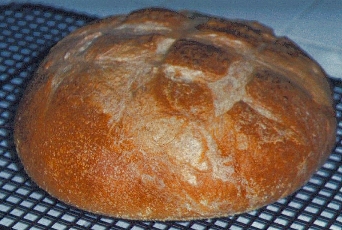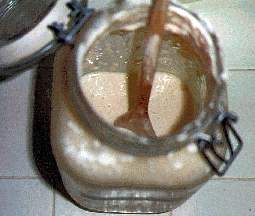
How to Make
Authentic
San Francisco
Sourdough French Bread
by Joe Jaworski
If you're a bread lover, nothing beats the tangy taste and chewy texture of sourdough bread. From its hard crust to its soft interior, sourdough bread has a unique flavor that is hard to resist. Although traditionally served with shellfish or seafood, sourdough bread can be served with most dishes, including red meats and poultry.

The most popular sourdough bread is made from true San Francisco yeast cultures, prepared in the french-style baking method. You probably have had sourdough bread before. But mass market sourdough bread is not made from wild yeast but from engineered yeasts with artificial flavors added. Once you taste bread made with real wild yeasts you will never go back.
Over the few years, I have tried many methods to reproduce the flavor of true San Francisco sourdough at home. My goal was to create a bread with equal or superior taste to the famous San Francisco bakeries of Boudin, Parisian, and Colombo. This article describes the process that I have developed that will produce excellent results in any home kitchen. My method is relatively simple, and if you currently bake any kind of yeast breads, you should have little difficulty following my recipe. While the start to finish time of baking this bread takes about 36 hours, there is very little to do most of this time.
Start with a Starter
Regular breads are made with commercial or engineered yeast. Sourdough breads are made from a starter. The starter (or sometimes called a sponge) is a flour and water mixture that contains the yeast used to rise the bread. You need a starter to make sourdough bread. To create a starter, you must first obtain some yeast. The only way to bake real San Francisco sourdough bread is to use a yeast culture from San Francisco. You can purchase dried yeast starters at some gourmet cook shops or larger health food stores. If you are associated with a cooking school or club, you might be able to get a bit of someone else's starter to start your own. On the net, Sourdoughs International sells various starters from around the world which I find are excellent. In any case, you cannot bake authentic San Francisco sourdough bread with just any sourdough starter, and certainly not with one derived from commercial yeast like Red Star or Fleischmann's.
It will take 24-36 hours to make a loaf, so plan ahead. I usually prepare my starter on Friday morning before work for bread that will be ready for Saturday's dinner. If you need more details on the ins and outs of sourdough starters, see my web page The Care and Feeding of Sourdough Starters before proceeding. If you're already baking sourdough but are having difficulties, see my sourdough FAQ for answers to common problems.

About a day and a half before bake time, remove your starter from the refrigerator. If it has some brown liquid on top (the "hooch" or alcohol layer) the starter is over fermented and needs to revived. Dump out all of it leaving about an inch of starter in the bottom of the jar. If the starter has been in refrigerator for a 3 weeks or more, Dump out all the starter except the amount clinging to the inside of the jar.
- - 1 cup (125 kg) of bread flour
- - 3/4 - 1 cup (250 ml) of warm water
Stir the mixture for a few minutes using a wooden or plastic spoon (never use metal bowls or utensils with yeast). The idea is to get lots of air into the mixture, which will help the yeast develop. The starter should wind up having the consistency of pancake batter.
You need to "proof" the starter, which is simply placing it in a dark place and letting it ferment. You can do this on the kitchen counter by covering the jar with a dark colored cloth or hand towel. For the first time using a brand new starter, it's best to use higher temperatures around 32C (90F) to prevent local yeast from contaminating the starter.

The starter needs to ferment for several hours. If you are familiar with sourdough baking, you know that sourdough starters have a "peak" in their bubbly activity, then tend to go flat or dormant after that. For best results, you want to ferment your starter right up to its peak. Depending upon how strong or weak your initial starter is plus temperature, the peak might take anywhere from 2 to 8 hours. With a new starter, check it every few hours or so to get an idea of when your starter reaches its peak. Don't worry if you are too early in the peak. But too late, and your bread won't rise enough. If you see lots of tiny bubble on the surface of the starter, it is ready to use.
Copyright (mc)1998-2018 Joe Jaworski. Reproduction by any means is strictly prohibited without permission.